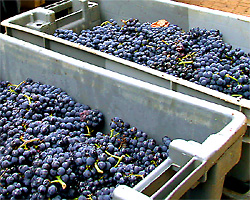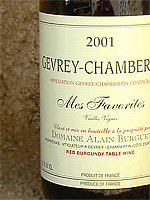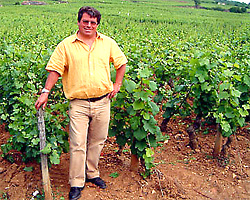Burgundy
This French wine region is an intricate, complex jigsaw puzzle of vineyards
by Eunice Fried Burgundy is as much a spirit as it is a land of wine. It is a string of tiny stone villages, so quiet and old and unassuming they belie their fame. It is hearty food, fine restaurants, quaint inns and small Romanesque churches. It is a labyrinth of cool, dark, deep cellars. It is the ruddy faced vintner in a beret working his few acres of precious land. It is wine with names as sonorous as the wines are sensuous.
Burgundy is as much a spirit as it is a land of wine. It is a string of tiny stone villages, so quiet and old and unassuming they belie their fame. It is hearty food, fine restaurants, quaint inns and small Romanesque churches. It is a labyrinth of cool, dark, deep cellars. It is the ruddy faced vintner in a beret working his few acres of precious land. It is wine with names as sonorous as the wines are sensuous.
The character of Burgundy is chiseled out of generations, its features a direct reflection of the region's long history. Wine was being made in Burgundy since at least the first century B.C. But the events that led to Burgundy's uniqueness began in the sixth century A.D. when a king of the region donated vineyard land to a religious order. Over the centuries, this gesture became a tradition so that eventually, much of the region's best vineyards belonged to religious orders. Of all the orders, it was the Cistercians who did the most to create the great vineyards and the great wines of Burgundy. From the early 1100's to the late 1700's, they planted vines, made wine, studied problems, improved methods, refined techniques and recorded their results. In the fourteenth century, they walled in the vineyard they had created through donations to make the 125-acre Clos de Vougeot. And they were the first to recognize subtle differences between wines made from grapes grown in different vineyards, even those that lay no more than a path apart.
If Burgundy's great vineyards were born with the Cistercians and other orders, their patchwork pattern was born with the French Revolution in the 1790's. In the aftermath of the Revolution, the vineyards of all the religious orders and those still belonging to the nobility were seized, split into small parcels and sold to the people.
The new owners split them further when by French law, they were now obliged to bequeath them equally to their children. Thus, if a vintner owned 10 acres and had five children, each would inherit two acres. In some instances, a sibling would sell his or her inheritance to another sibling more interested in working the land. Still, over generations of multiple inheritances, while a vineyard would stay intact, it was divided among many owners, each tending his or her sliver of the land apart from other owners. The 125-acre Clos de Vougeot created and once owned by the Cistercians is now divided among some 80 owners, for example, and the 18.5-acre Montrachet vineyard has over a dozen owners. Only a few vineyards --- the two-acre La Romanée and the 4.5-acre Romanée-Conti, among them—have a single owner.
The region defined as Viticultural Burgundy producing A.O.C., or legally controlled-appellation wines, is an elongated stretch with Chablis at the northern end, separated from the rest of Burgundy by some 70 miles, and Beaujolais, Côte de Chalonnaise and the Mâconnais at the southern end. Between the two, beginning just south of Dijon, lies the Côte d'Or, or Slope of Gold, a glorious 30-miles ribbon of vineyards that runs along the western hills where vines reach toward the sun on its long arc across the sky.
 This is the heart of Burgundy, both geographically and spiritually. This is the home of Burgundy's greatest wines. The northern part of the Côte d'Or is called the Côte de Nuits; the southern part is called Côte de Beaune. In the center is the medieval town of Beaune, and it represents the soul of the region.
This is the heart of Burgundy, both geographically and spiritually. This is the home of Burgundy's greatest wines. The northern part of the Côte d'Or is called the Côte de Nuits; the southern part is called Côte de Beaune. In the center is the medieval town of Beaune, and it represents the soul of the region.
Unlike some regions where the best wines are blends of two or more grapes, in Burgundy, all great white wines are made from the Chardonnay grape and all great reds are made from Pinot Noir. Other reds, such as Beaujolais, are produced from the Gamay grape, and some pleasant whites are made from the Aligoté grape.
As in all of France, Burgundy's vineyard names are controlled by the A.O.C., or Appellation d'Origine Contrôlée, law. Burgundy, however, with its myriad little patches, like parts of an intricate jigsaw puzzle and differing from each other often by the slightest variation in its wines, creates a complex picture. In the 30 miles of the Côte d'Or, there are more than 60 appellations classified into four major categories. There is, first, the regional appellation of Burgundy which means the grapes were grown anywhere in Burgundy. From there, we move to the village appellation for wines made from grapes grown in designated vineyards of a given village—Meursault or Volnay, for example. Going up the quality scale are individually named vineyards within a village that have been legally proclaimed Premier Cru, or First Growth. An example is the Grèves vineyard in Beaune. Its label can read Beaune-Grèves or Beaune Premier Cru or Beaune-Grèves, Premier Cru. In any case, it would also say, "Appellation Contrôlée." The most distinguished wines of Burgundy are those of the Grand Cru or Great Growth vineyards. Because of their reputation as the region's finest, they can be labeled solely with their vineyard name such as Montrachet, Corton, La Tâche and Chambertin. There are, in all, only 31 Grand Cru vineyards in Burgundy, and each is an appellation unto itself.
With such an intricate system, how does one choose a Burgundy? By discovering which vintners', négociants' and brokers' wines one likes best. And that, of course, can only be done by tasting.
Anyone fortunate enough to find the excellent wines of the Côte de Beaune vintners, Domaine Michel Lafarge and Domaine des Comtes Lafon, will have a fine introduction to Burgundy. Michel Lafarge produces mainly the red wines of Volnay and Beaune-Grèves and some Pommard; Lafon has its major production in the white Meursault and some Volnay and a bit of the famed white wine vineyard, Montrachet. Both vintners have limited productions; both are worth seeking out.
 Another vintner who personifies the spirit of Burgundy is Alain Burguet whose holdings are mostly in the village Gevrey Chambertin on the Côte de Nuits. His lovely Gevrey Chambertin Mes Favorites Vieilles Vignes 2001 is a village wine, made from vines that average 60 years of age, that captures the elusive essence of Pinot Noir. And his regional bottling, Domaine Alain Burguet Bourgogne Rouge, is at $25 one of Burgundy's bargains.
Another vintner who personifies the spirit of Burgundy is Alain Burguet whose holdings are mostly in the village Gevrey Chambertin on the Côte de Nuits. His lovely Gevrey Chambertin Mes Favorites Vieilles Vignes 2001 is a village wine, made from vines that average 60 years of age, that captures the elusive essence of Pinot Noir. And his regional bottling, Domaine Alain Burguet Bourgogne Rouge, is at $25 one of Burgundy's bargains.
Also along the Côte de Nuits, where most of the wine is red, are Domaine Denis Bachelet Charmes Chambertin 2000 with its wonderfully deep aroma, made from old vines; Domaine Lignier-Michelot Morey St. Denis Premier Cru Faconnières 2002 with its delicious, forward fruit; and Domaine des Monts Luisants rich Premier Cru Les Genevrières 2001 and its deep, satiny Premier Cru Les Monts Luisants 2001. Add to them, the worthy Domaine Dominique Mugneret's delicate Nuits St. George Premier Cru Les Boudots 2001 and its glorious, deep, Echezeaux Grand Cru 2001; and Domaine J. F. Mugnier Le Musigny Grand Cru 2001, rich, well balanced, with a lingering finish, a beautiful wine. Also beautiful is Maison Camille Giroud's Vosne-Romanée Premier Cru Les Malconsorts 2001, deep and inviting, all satin and warmth.
Along the Côte de Beaune where both red and white wines are dominant, we recommend Domaine Matrot-Wittersheim's lovely Volnay Premier Cru Santenots 2001 with its cherry-like flavors; Domain Coste Caumartin's Pommard Premier Cru Le Clos des Boucherottes 2001 Monopole; Saint Romain Blanc "Sous Le Château" 2000 and 2001; and Domaine Hubert Lamy Saint Aubin Blanc "La Princée" 2002 whose fruit flavors fairly leap out of the glass.
Burgundy's wines do not announce themselves with thunder and lightening. They enter with elegance and satin and silk. Like the medieval countryside of Burgundy, they are a quiet and pleasurable and satisfying discovery.

